Top Image: Female foreign workers in Stadelheim work in a factory owned by the AGFA camera company, May 1943, Germany, United States Holocaust Memorial Museum, courtesy of the National Archives, 09047.
In August 1944, there were over 7.6 million Fremdarbeiter (foreign workers) officially registered on the employment rolls in the territory of the “Greater German Reich,” representing one-fifth of the total labor force. Of those, 1.9 million were prisoners of war and 5.7 million were civilian forced laborers. Eastern Europeans made up the majority of civilian forced laborers, a term used to describe people who were involuntarily taken from their homes and deported to work in various places throughout the Third Reich during World War II.
Nazi labor policy in the occupied Eastern Europe was developed in response to the wartime circumstances with the Soviet Union, and became increasingly radicalized after the Wehrmacht faced setbacks in their quests to take Moscow and Stalingrad. Labor policy in Eastern Europe was also directly related to Nazi racial ideology, which viewed Slavic peoples as Untermenschen, or subhuman.
As Dr. Otto Bräutigam, a high ranking official in the Ministry for the Occupied Eastern Territories, stated in a secret memorandum:
"With the inherent instinct of the Eastern peoples, the primitive man soon found out that for Germany the slogan: ‘Liberation from Bolshevism’ was only a pretext to enslave the Eastern peoples according to her own methods…With unequaled presumption, we put aside all political knowledge and treated the peoples of the occupied Eastern territories as ‘Second Class Whites’ to whom Providence has merely assigned the task of serving as slaves for Germany."
Nazi labor officials had always planned to utilize foreign labor from Eastern Europe during the war, but there was no masterplan for a comprehensive forced labor program. Instead, the combination of Nazi racial philosophy, labor shortages in Germany, and setbacks on the Eastern Front coalesced to create an extensive forced labor policy. This was characterized by “recruitment quotas,” increasingly violent methods to procure Eastern European workers, and involuntary deportations.
Labor Policy in Occupied Western Poland 1939-1941
After Hitler assumed power in 1933, the new Nazi government implemented an extensive propaganda campaign to remove women from all gainful employment. Nazi racial and social philosophy extolled the virtues of motherhood and produced a series of incentives to increase the birth rate in Germany. Keeping women out of the workforce became a key factor in the decision to exploit Polish labor when 4.4 million men were drafted out of the German economy into the armed forces between 1939 and 1940.
According to the historian Edward L. Homze:
“The social policy of the Nazis regarding women and their role in society had a direct bearing on the Nazi decision to mobilize foreign labor. Rather than attempting to intensify the mobilization of native, especially female labor, the Nazis followed a seemingly easier course; they recruited millions of foreigners.”
The earliest mention of the use of foreign labor to fill unemployment gaps during prewar planning occurred at a meeting on May 23, 1939, between Adolf Hitler, Herman Göring, Erich Raeder, Wilhelm Keitel, and representatives of the German armed services. According to the minutes of the meeting, Hitler stated that after an attack on Poland, “the population of the non-German areas will perform no military service, and will be available as a source of labor.”
The use of foreign labor in Germany was not a new innovation. Since the late nineteenth century, foreign labor had been vital to the German economy. During the rapid industrialization of Imperial Germany in the 1870s and 1880s, landowners (especially in eastern Germany) increasingly replaced migrating German workers with seasonal Polish workers. Imperial Germany also utilized Polish and Belgian workers during World War I but also relied heavily on prisoners of war to fill labor needs.
The speed and success of the attack on Poland in September 1939 contributed to the inception of a foreign labor plan since it opened new vistas for Nazi social and economic planners. The entire Polish Army, numbering close to 1 million, fell captive to the Wehrmacht, and the occupation of the western half of Poland left millions of Polish civilians subject to labor exploitation.
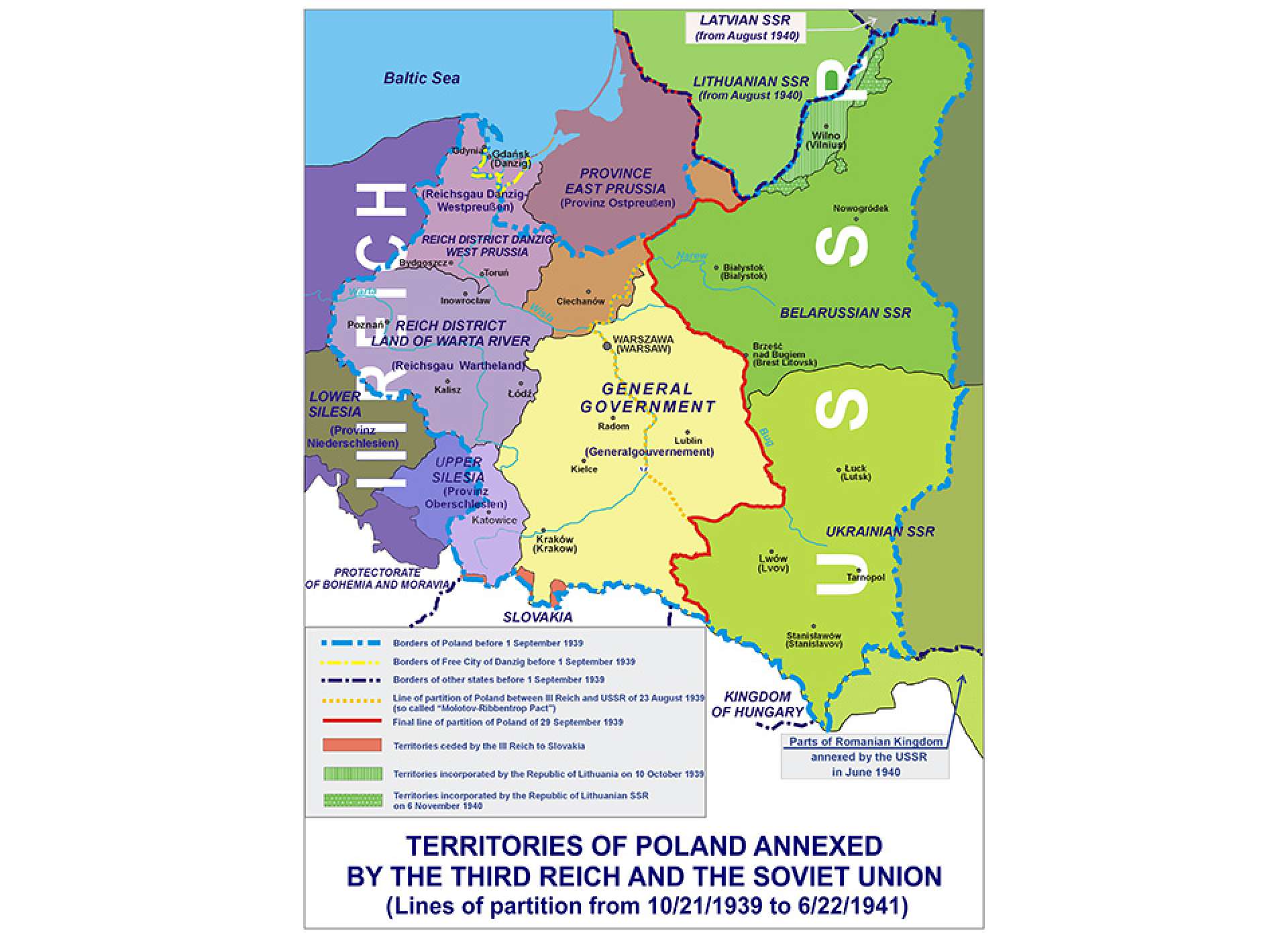
Until the Molotov-Ribbentrop Pact of 1939, Poland was split between Germany and Poland. The Soviet Union received the eastern half of Poland while the western half of Poland was divided into the Gau OF West Prussia, often referred to the Wartheland or Warthegau. The rest of German-occupied Poland was organized into the “General Government.” “Poland occupied by Nazi Germany (Third Reich) and the USSR,” March 27, 2014, retrieved via Wikicommons.
The use of Polish labor to sustain the German war machine was based on Nazi racial ideology, which placed the Slavic population at the bottom of the Nazi racial scale—slightly above Jews, Roma, and Sinti. According to Hitler, Slavs were an inferior race, “especially born for low labor.” He often argued that “there can be no question of improvement for them [Slavs]” and that it was “necessary to keep their standard of life low.”
Erich Koch, a Gauleiter of the Nazi Party in East Prussia and Reichskommissar of the Reichskommissariat Ukraine, echoed Hitler’s sentiments. He stated that Slavs were “racially and biologically a thousand times inferior compared to the lowliest German worker” in a 1941 speech.
As a result, within the first few months of occupation, Nazi labor officials repealed Polish social legislation, abolished all Polish labor organizations, and promulgated new laws and decrees concerning wages, hours, and working conditions. One of the first labor laws, issued on October 26, 1939, stated that “all Polish inhabitants between the ages of 18 and 60 shall be subject to compulsory public labor.” This included the construction and maintenance of public buildings, roads, waterways, railways, and “agricultural undertakings.”
In addition to compulsory labor registration, Nazi authorities also recruited civilian volunteers to work in Germany for three to six month stays. Three days after the Wehrmacht crossed the Polish border, the German Ministry for Labor quickly established labor offices in the Polish towns of Rybnik and Dirshau. By September 15, 1939, there were nearly 30 labor offices in operation to enlist Poles to work in Germany—a number that expanded to 115 by the beginning of October.
The German effort to secure Polish labor was extremely successful. In May of 1940, there were approximately 700,000 Polish civilians working in Germany. Almost a year later, on the eve of Operation Barbarossa, there were close to 1.3 million civilian workers in Germany, most of which came from Poland and were employed in agriculture. Employing Poles to work in Germany increased the percentage of foreign labor from one percent to three percent of the Reich’s labor force, which was the first significant step in the mobilization of foreign labor during World War II.
Initial Labor Policy in Occupied Eastern Territories
The German invasion of the Soviet Union on June 22, 1941, resulted in the Nazi acquisition of the eastern half of Poland, Lithuania, Latvia, Estonia, Ukraine, Belarus, and parts of Russia. Nazi labor authorities quickly laid out plans to utilize Eastern European labor based on the strategies applied in Poland.
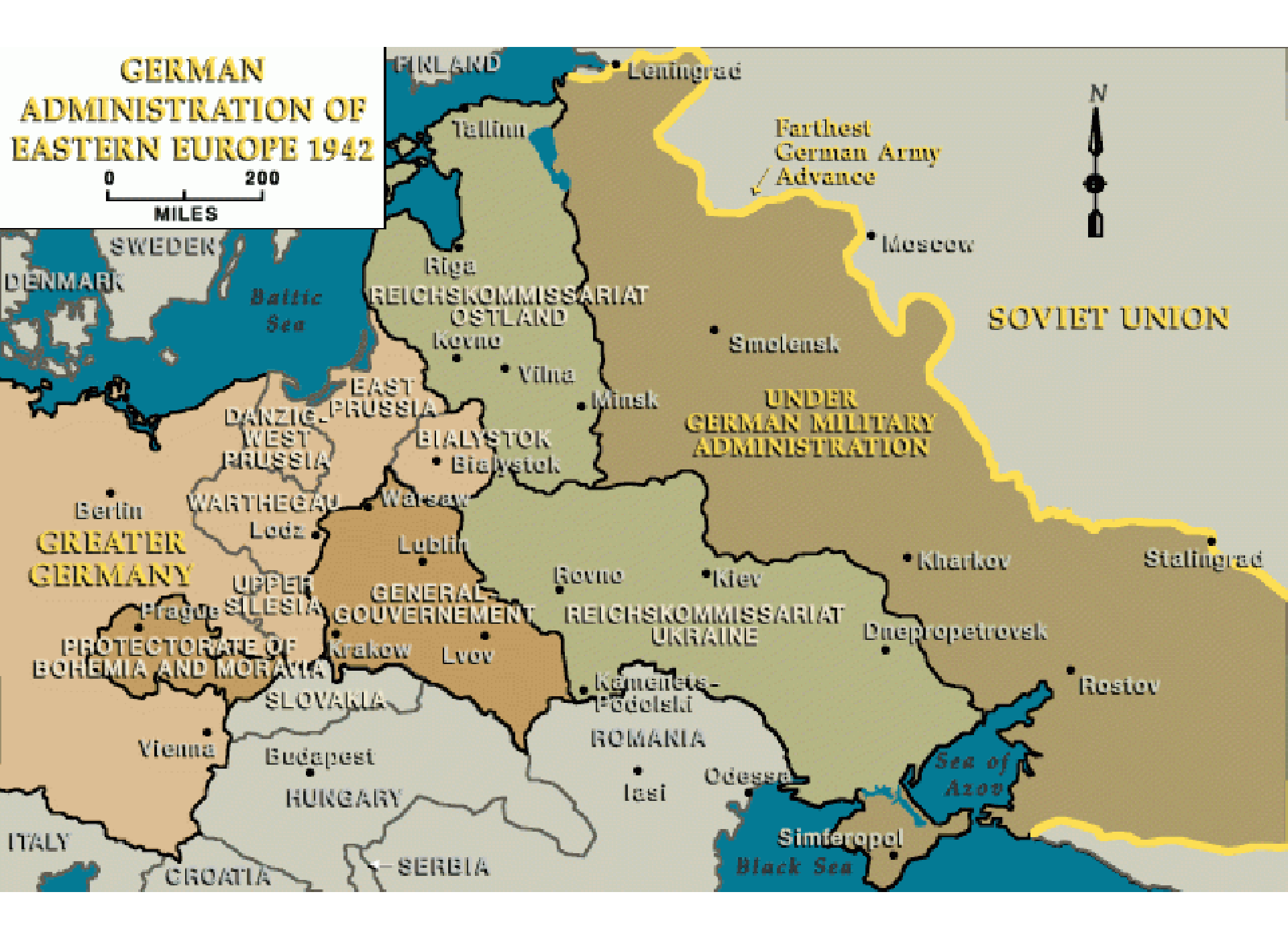
“Map of German Administration, 1942,” courtesy of United States Holocaust Memorial Museum.
Initial labor policy in the Occupied Eastern Territories relied heavily on political enemies, POWs, and the Jewish population for the most labor-intensive tasks. They were forced to repair roads, raze buildings that could not be repaired, clear spaces for new construction sites, restore bridges, and shovel snow. In one extreme example, local police units detained and forced the Jewish people of L’viv and Brzezany, both located within the present-day borders of Ukraine, to exhume and rebury bodies of thousands of Ukrainians who were murdered at the hands of the NKVD in the Great Prison Massacres.
Conditions for both Jews and POWs were extremely harsh since Nazi authorities required these “enemies of the state” to work long hours without breaks and poor nourishment. As Yosef Laufer, a Jewish survivor, remembered:
“We used to take weeds with us to work that we had gathered from the fields and cooked. People collapsed from exhaustion and did not have the strength to return home after a day’s work.”
Yosef Laufer
Initial labor policy also required all inhabitants between the ages of 16 and 60 in German-occupied territories in Eastern Europe to register with the German Labor Front (Deutsche Arbeitsfront, or DAF), an institution controlled by city or district commissars. Those who spoke German were placed in clerical jobs assisting German officials, translating documents, and acting as interpreters. DAF employed the rest in factories or assigned them to work on farms. Although these were paid jobs, the amount of payment, quality of food rations, and working conditions steadily deteriorated over the course of German occupation.
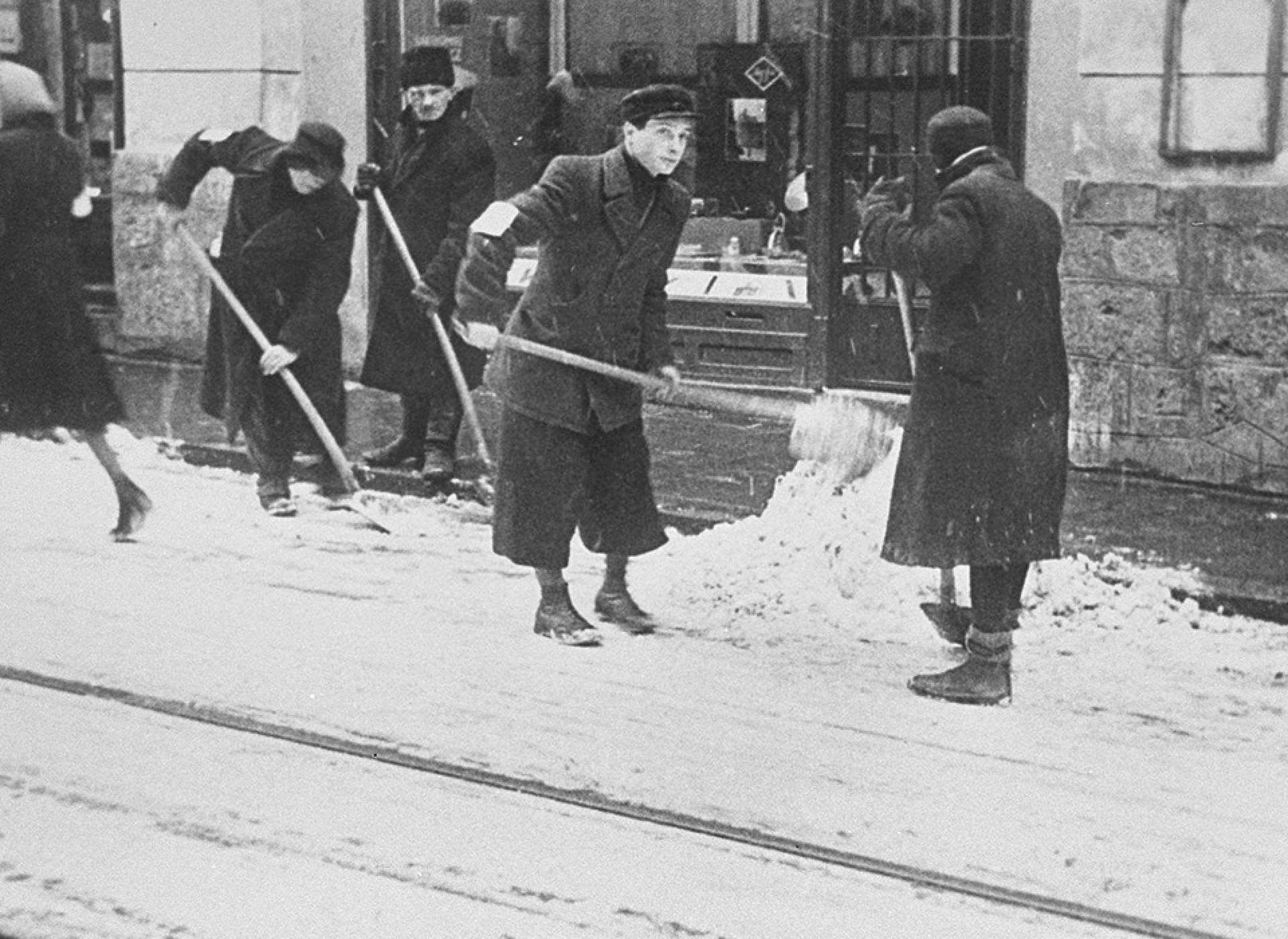
Jews wearing armbands are forced to shovel snow from the pavement in Krakow, circa 1940, Krakow Poland, United States Holocaust Memorial Museum, courtesy of Archiwum Panstwowe w Krakowie, 07122.
By the fall of 1941, however, the number of Jews, POWs, and communist detainees used as sources of labor began to shrink following the construction of ghettos, the “Holocaust by bullets” and the systematic starvation of Soviet POWs. Unexpected military setbacks on the Eastern Front also compounded labor shortages, forcing Nazi officials to reformulate their labor policies in Eastern Europe.
Voluntary Labor Program
In November 1941, the German Labor Front created a volunteer work program for men and women living in the Occupied Eastern Territories, based on the model used in Poland. The program promised high wages, additional food rations, and better housing in exchange for a six-month stay working in Germany. Posters, newspaper ads, and leaflets calling for able-bodied men and women between the ages of 16 and 50 to volunteer were distributed throughout cities, towns, and villages. Nazi authorities also encouraged Catholic and Orthodox church leaders to publicize the volunteer work program during church services.
At first, this volunteer program was extremely successful, with the number of volunteers exceeding German expectations. For instance, in Kharkiv, located in the easternmost part of present-day Ukraine, trains transported 1,000 workers twice a week for three consecutive months. The Polish city of Krakow also reported thousands of young men and women signing contracts to work in Germany for six months.
Former volunteer workers list many different factors that influenced their decision to leave home and work in Germany. These motives included the hope for better economic opportunities, the chance to learn a skilled trade, the pervasiveness of Nazi propaganda, and the prospect of adventure that came with traveling to a new country.

Photo of an Arbeitsbuch für Ausländer. Popowycz Family Forced Labor Documentation taken by the author in August 2017.
The enthusiastic response to the volunteer labor program, however, quickly diminished when letters and postcards sent to family members back home reported poor housing conditions, long working hours, lower wages than promised, and physical and emotional abuse. For example, in June 1942, there were 4,030 people who volunteered in Kyiv, but by September, that number dropped to only five. In most instances, those who volunteered were not allowed to return home after their six-month stay.
As the number of volunteers declined, the need for foreign labor increased. Setbacks on the Eastern Front demanded an increase in manufacturing and armaments production, which led to the use of force to assign and collect people for labor deployment.
Forced Deportation to Germany
The substantial decrease in volunteers coincided with the appointment of Fritz Sauckel as Plenipotentiary General for the Utilization of Labor (Generalbevollmächtigter für den Arbeitseinsatz, or GBA). In late March 1942, Sauckel devised a new labor policy that relied on compulsory labor conscription for all of the Eastern Occupied Territories. This policy completely overhauled and radicalized the entire Nazi labor system in terms of the number of people assigned to work in Germany, the methods used to enlist laborers, and the treatment of forced laborers.
As part of Sauckel’s forced labor policy, he established quotas, which were passed down to district and city commissars, requesting a certain number of people be deployed to Germany. Sauckel also formed a Recruitment Commission (Anwerbekommissionen des GBA) to oversee the entire labor deportation process, and doubled the number of labor officials in all of the occupied territories in Eastern Europe. This included an additional 200 labor officers who were assigned the military rank of Sonderführer to facilitate coordination for rounding up civilians with the Wehrmacht.
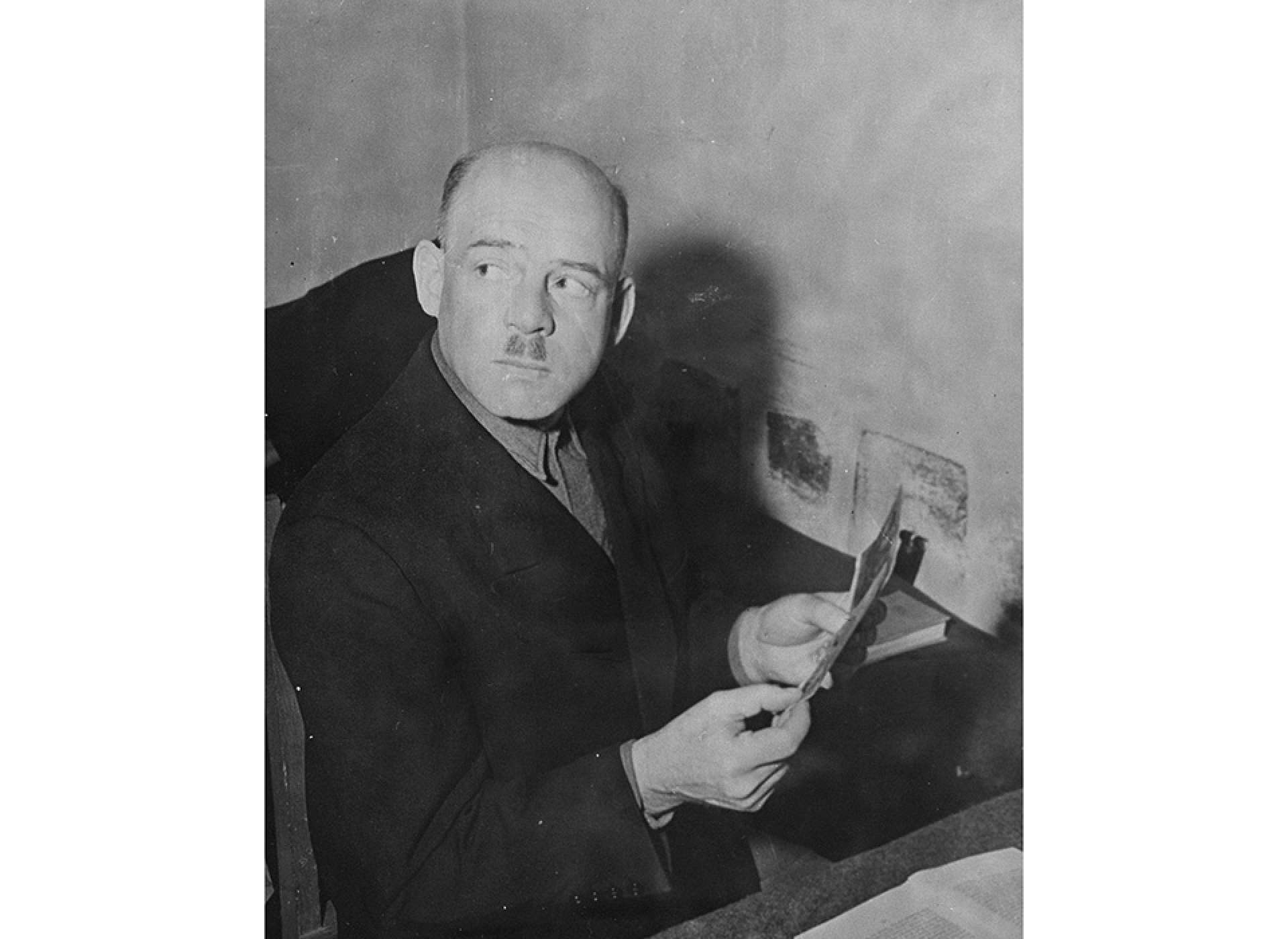
Fritz Sauckel, the former Plenipotentiary General for Labor, in his prison cell at the International Military Tribunal trial of war criminals at Nuremberg, November 20, 1945 - October 1, 1946, Nuremberg. United States Holocaust Memorial Museum photo, courtesy of National Archives, 14132.
Initially, forced labor procurement was fairly systematized. Once Sauckel established a new quota, his representatives in the Labor Office relayed the targeted numbers to district commissars, who were then responsible for dividing the quotas throughout the district. Although Sauckel set labor quotas, the local municipal administration was directly responsible for who was conscripted, which resulted in local authorities choosing political adversaries, personal enemies, and ethnic rivals for deportation.
As the war progressed, however, the methods for rounding up people became more chaotic and violent as officials clamored to meet the quotas established by Sauckel. In August 1942, Sauckel and Alfred Rosenberg, the Reich Minister for the Occupied East, approved the use of force by the Wehrmacht during recruitment campaigns if people refused to comply. Although, it is difficult to identify an exact point when Nazi authorities began to rely on the use of force to fulfill labor quotas. Some historians, however, have pointed to the Battle of Stalingrad as a significant turning point in the treatment of civilians during recruitment drives, as more severe losses on the Eastern Front led to more brutal tactics.
Memoirs and testimonies by former forced laborers attest to the more radical and violent methods used by the Wehrmacht to recruit and deploy Eastern Europeans to work in Germany. Many describe “massive manhunts” in which Nazi authorities picked people up off the streets and pulled people out of their homes. In some instances, young adults were taken during school or church services.
Police also threatened to harm relatives in order to coerce Eastern Europeans to comply with labor conscription orders. By the beginning of 1943, failure to enlist resulted in severe beatings and, occasionally, death. One report from the Ukrainian Central Committee, an organization set up to act as mediator between Nazi authorities and the Ukrainian speaking population in the General Government, recorded 16 arrests and killings in labor recruitment operations in the month of February 1943.
The intensification of unregulated force and violence led to an increase in active resistance against Nazi occupiers, especially among younger populations. The historian Karel Berkhoff notes several instances of young adults drinking a tobacco “tea,” smoking tobacco leaves, and ingesting small amounts of poison to create sickly complexions during medical examinations. Others resorted to self-mutilation—crippling themselves by jumping out of windows, chopping off fingers and hands, or burning themselves with sulfuric acid. Most who fled recruitment officers, however, flocked to the forests to hide with partisans or joined underground nationalist movements.
As more people resisted deportation, officials on the ground developed even harsher penalties for failure to comply with Nazi forced labor policy. For example, the General Commissar Schöne of the Volhynia-Podolia district approved burning the homes of those who refused to show up for deportation. The General Commissar in Luzk issued a similar decree, dated September 31, 1943, stating “the farms of persons who refuse to work should be burned down, their relatives taken hostage and placed in concentration camps.”
In a few cases, entire villages were burned to the ground, including the village of Bilozirka (located in present-day Ukraine) and the village of Sumyn in Lublin (today a part of Poland). This was done as retribution for failure to provide the designated number of labor conscripts.
The Evolution of Nazi Labor Policy
The critical manpower shortage in the German economy, elements of National Socialist racial ideology and utopianism, setbacks on the Eastern Front, and Nazi regimentation and militarization of labor relations were all decisive factors in the radicalization of labor policy in Nazi-occupied Eastern Europe. What began as a labor program based on contracted volunteer labor in Poland between 1939 and 1941, transformed into a forced labor initiative throughout Eastern Europe characterized by intimidation, physical force, violence, destruction of homes, and the occasional annihilation of entire villages by 1943-1944.
While the primary purpose of forcing millions of people from Belarus, Estonia, Latvia, Lithuania, Poland, Ukraine, and Yugoslavia was to satisfy labor needs for the Nazi war machine, the forced labor program in Eastern Europe was also designed to substantially weaken the Slavic population. It worked.
The violence used to fulfill labor quotas left native populations in Eastern Europe anxious and terrified, as they increasingly feared forced deportation and what their lives as Untermenschen working in Germany would look like. Consequently, the horrific experience of forced labor remains a powerful illustration of the fundamental brutality that characterized the Nazi occupation of Eastern Europe.
Jennifer Popowycz, PhD
Jennifer Popowycz, PhD is the Leventhal Research Fellow at The National WWII Museum. Her research focuses on the Eastern Front and Nazi occupation policies in Eastern Europe in World War II.
Cite this article:
MLA Citation:
APA Citation:
Chicago Style Citation:
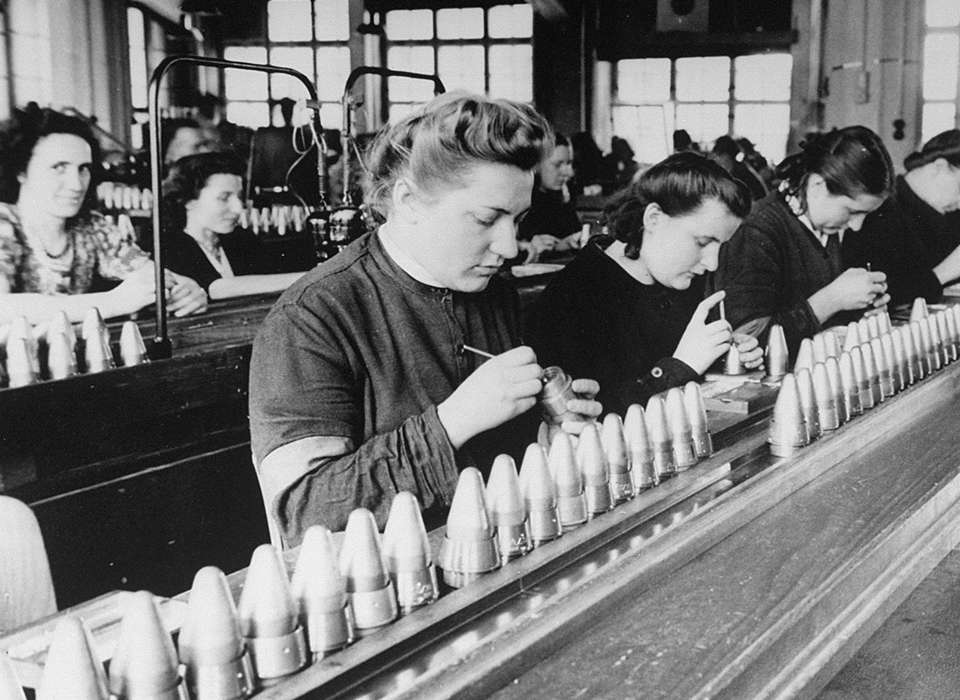




![Max Fuchs, New York City cantor, sings as Rabbi Sydney [sic] Lefkowitz, Richmond, VA, conducts the first Jewish services from Germany.](/sites/default/files/styles/max_650x650/public/2025-10/image1.jpg)



